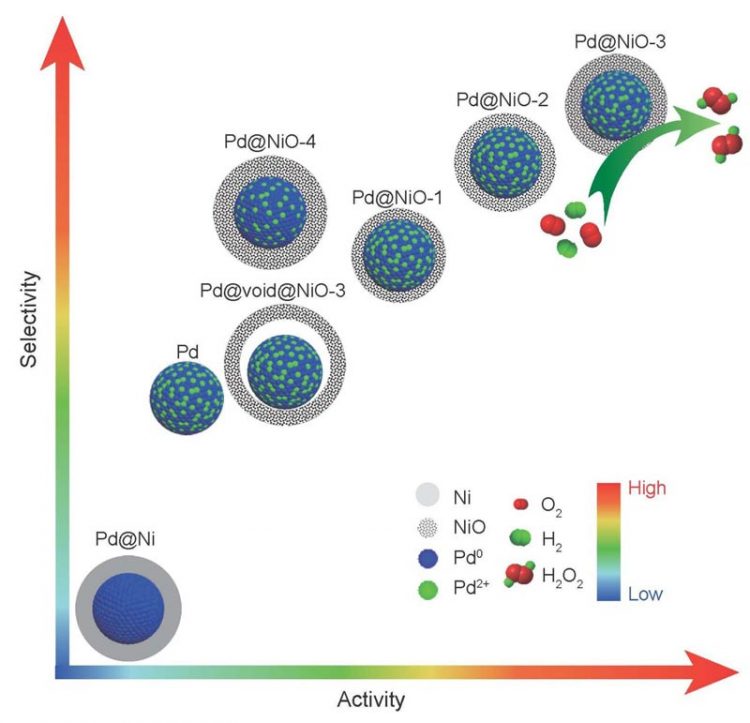Interfacial engineering core@shell nanoparticles for active and selective direct H2O2 generation

This is a schematic illustration showing the activity and selectivity toward H2O2 synthesis of 5 wt% Pd@Ni-3/TiO2, 5 wt% Pd@NiO-x/TiO2 (x = 1, 2, 3, 4), 5 wt% Pd@void@Ni-3/TiO2 and 5 wt% Pd/TiO2. Credit: ©Science China Press
Hitherto, the direct synthetic route is mainly achieved by the supported Pd-based catalysts. The major problem associated with that is related to the low selectivity of H2O2. Despite great efforts have been devoted to constructing the Pd-based catalysts by introducing the second metals, understanding high-performance Pd-based catalysts for the direct H2O2 generation from either deep characterization or theoretical investigation are still extremely limited.
In a new overview published in the Beijing-based National Science Review, scientists at the Soochow University present the latest advances in direct H2O2 generation. Co-authors Yonggang Feng, Qi Shao, Bolong Huang, Junbo Zhang, and Xiaoqing Huang developed a class of Pd@NiO-x nanoparticles with unique core@shell interface structure, which achieves high activity, selectivity and stability for the direct H2O2 synthesis.
These scientists likewise interpreted the mechanism from both electronic and energetic views.
“Traditional Pd-based catalysts are very active for the side reactions, such as the decomposition and hydrogenation of H2O2 as well as the formation of H2O,” they state in an article titled “Surface engineering in the interface of core/shell nanoparticles promotes hydrogen peroxide generation”.
“It is considered that the intrinsic surface property of Pd-based catalysts is essential for the selectivity and activity of the direct H2O2 synthesis,” they add. “This arises because the barrier for O-O bond scission is sensitive to Pd surface structure, the key parameter governing H2O2 synthesis and decomposition activity.”
The creation of porous NiO shell is beneficial for exposing Pd active sites and thus enhancing the productivity of H2O2. “By tuning the composition of Pd@NiO-x NPs and the reaction condition, the efficiency of H2O2 synthesis could be well optimized with 5 wt% Pd@NiO-3/TiO2 exhibiting the highest productivity (89 mol/(kgcath)) and selectivity (91%) to H2O2 as well as excellent stability,” they state.
“The first principles simulations further revealed the mechanism from both electronic and energetic views,” the scientists interpreted. “The superiority in selectivity is achieved by a spontaneous bond scission of H-H and charge transfer from O20 to O22- within the cavity of NiO interfacing with Pd surface.,”
“The high selectivity and activity making it one of the best catalysts for the direct H2O2 synthesis reported to date,” they add. “The present work reported here highlights the importance of surface and interface engineering of Pd-based catalysts for the direct H2O2 synthesis with largely enhanced activity and selectivity.”
###
This research received funding from the Ministry of Science and Technology (2016YFA0204100, 2017YFA0208200), the National Natural Science Foundation of China (21571135), Young Thousand Talented Program, Jiangsu Province Natural Science Fund for Distinguished Young Scholars (BK20170003), the project of scientific and technologic infrastructure of Suzhou (SZS201708), the start-up supports from Soochow University, and the Priority Academic Program Development of Jiangsu Higher Education Institutions (PAPD).
See the article:
Yonggang Feng, Qi Shao, Bolong Huang, Junbo Zhang, and Xiaoqing Huang
Surface Engineering in the Interface of Core/Shell Nanoparticles Promotes Hydrogen Peroxide Generation
Natl Sci Rev
https:/
The National Science Review is the first comprehensive scholarly journal released in English in China that is aimed at linking the country's rapidly advancing community of scientists with the global frontiers of science and technology. The journal also aims to shine a worldwide spotlight on scientific research advances across China.
Media Contact
More Information:
http://dx.doi.org/10.1093/nsr/nwy065All latest news from the category: Life Sciences and Chemistry
Articles and reports from the Life Sciences and chemistry area deal with applied and basic research into modern biology, chemistry and human medicine.
Valuable information can be found on a range of life sciences fields including bacteriology, biochemistry, bionics, bioinformatics, biophysics, biotechnology, genetics, geobotany, human biology, marine biology, microbiology, molecular biology, cellular biology, zoology, bioinorganic chemistry, microchemistry and environmental chemistry.
Newest articles

First-of-its-kind study uses remote sensing to monitor plastic debris in rivers and lakes
Remote sensing creates a cost-effective solution to monitoring plastic pollution. A first-of-its-kind study from researchers at the University of Minnesota Twin Cities shows how remote sensing can help monitor and…

Laser-based artificial neuron mimics nerve cell functions at lightning speed
With a processing speed a billion times faster than nature, chip-based laser neuron could help advance AI tasks such as pattern recognition and sequence prediction. Researchers have developed a laser-based…

Optimising the processing of plastic waste
Just one look in the yellow bin reveals a colourful jumble of different types of plastic. However, the purer and more uniform plastic waste is, the easier it is to…



